 |
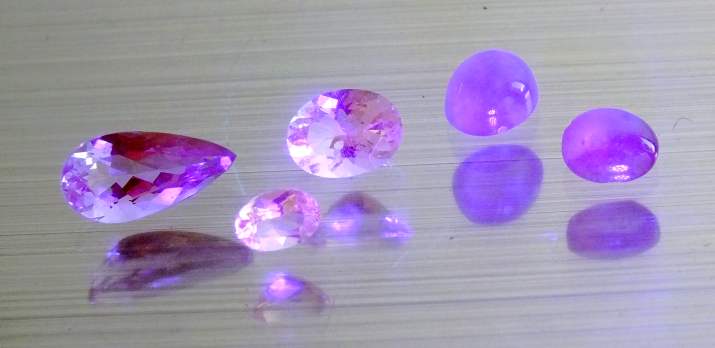 |
| 方曹達石(ソーダライト)/ハックマン石(Hackmanite) 0.29 - 1.35ct 自然光と紫外線光 | |
方曹達石(ソーダライト:Sodalite)/ハックマン石(Hackmanite)
 |
 |
| 方曹達石(ソーダライト)/ハックマン石(Hackmanite) 0.29 - 1.35ct 自然光と紫外線光 | |
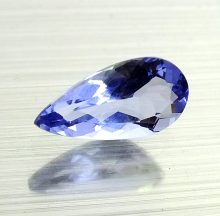 |
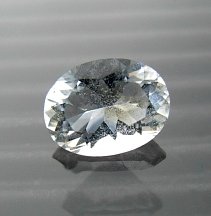 |
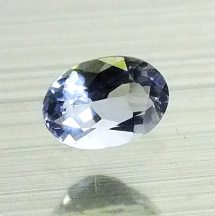 |
 |
|
| 1.35ct 11.6x5.9mm | 0.73ct 7.6x5.6mm | 0.29ct 5.50x3.84mm | 1.01ct 6.7x6.0mm | 1.14ct 6.4x4.9mm |
| Kokscha Valley, Afghanistan | Mogok, Burma | |||
1990年代末から2000年代初頭にかけて、宝石質の透明、あるいは亜透明のソーダライトが世界各地から発見されるようになりました。
上の写真は、アフガニスタンとビルマのモゴク地方からのソーダライトですが、長波紫外線照射により、青い蛍光を発し、ピンクになり、照射を止めると元の色に戻る、テネブレッセンス効果を示すことから、いずれもごく微量の硫黄を含むハックマン石であることが判明しました。
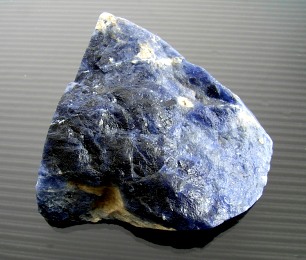 |
 |
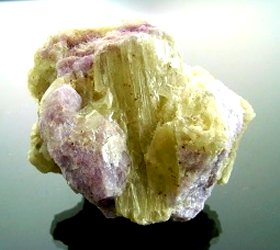 |
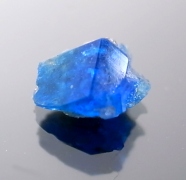 |
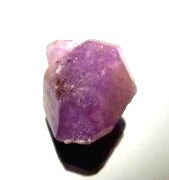 |
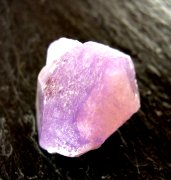 |
| 方曹達石(Sodalite)65x62x33mm | フォルステライトと方曹達石結晶(3cm) Forsterite and Sodalite(3cm)crystal |
ハックマン石(Hackmanite) | |||
| 80x60x60mm | 5.0x4.6x4.1mm | 16x12mm | |||
| Bahia, Brazil | Kokscha Valley、 Afghanistan | ||||
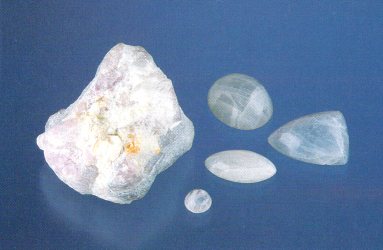 |
 |
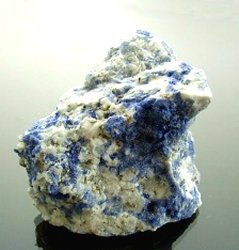 |
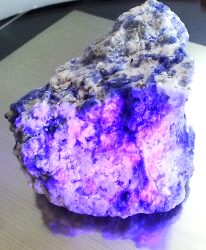 |
| 自然光と長波紫外線照射時の色の変化を示すハックマン石 ラフ 46mm カボションルース 〜 1.92ct | Hackmanite 81x72x50mm | 長波紫外線照射時 | |
| Dattawa Mine, Mogok, Burma | Mont Saint-Hilaire, Quebec, Canada | ||
| 化学組成 (Composition) |
結晶系 (Crystal System) |
結晶形 (Crystal forms) |
モース硬度 (Hardness) |
比重 (Density) |
屈折率 (Refractive Index) |
||
| 方曹達石 (Sodalite) |
Na8Al6Si6O24Cl2 | 等軸晶系 (Cubic) |
 |
 |
5½ - 6 | 2.3 | 1.483-487 |
| ハックマン石 (Hackmanite) |
Na8Al6Si6O24(Cl2,S) | 等軸晶系 (Cubic) |
5½ - 6 | 2.3 | 1.483-487 | ||
名前と産状(About name and occurence)
英語の名前はこの鉱物が主成分として酸化ナトリウム (Na2O) が 25% 含まれるため。和名にはさらに立方晶系 (等軸晶系) を示す "方” を語頭に追加してこの鉱物の結晶系と主成分とが簡潔に表されています。
火成岩起源の鉱物でアルカリ閃長岩やフォノライト (響岩) 中に霞石、ジルコン、チタナイトと共に、或いは大理石中に熱水起源で産します。こうした産状はかなり稀なため産地は限られています ; カナダ、オンタリオ州、バンクロフトのプリンセス・ソーダライト鉱山やルーマニアのディトゥラウからは粒状の団塊で採掘されます。またグリーンランドでは10cmもの結晶が採れます。
その他にドイツ、アイフェル山地のラーハー湖、イタリアのモンテ・ソマ、ボリビアのセロ・サポ、ブラジルのバイア州、ビルマ、アメリカのニュー・ジャージー州、、ロシアのコラ半島等にも産します。
ごく最近(2005年),アフガニスタンのラピス・ラズリ産地の近くからフォルステライトを伴う見事なソーダライト結晶が報告されました。
The name derives from major composition, 25% of Na2O. Magmatic origine in alkaline syenites and phonolites, associated with nepheline, zircon and titanite; hydrothermal in marbles. Granular agregates are known from the Princess Sodalite mine, Bancroft, Ontario, Canada and Ditrau, Romania. Crystals up to 100mm across come from Kangerdluarssuk, Greenland. Other localities are Laacher See, Eiffel heights, Germany, Monte Somma, Italy, Cerro Sapo, Bolivia, Bahia Brazil, Birma, Kola Peninsula, Russia and New Jersey, U.S.A.,etc. Fairly recently(2005), superb sodalite crystal associated with forsterite crystal was reported near Lapis-lazuli mine, in Afghanistan.
ハックマン石はソーダライトの塩素成分のごく一部 (0.05〜0.3wt%Cl2) が硫黄に置き換えられた変種で、フィンランドの地質学者ヴィクトール・ハックマンに因む命名です。
大変稀な鉱物ですが、1980年代にカナダ・ケベック州のモン・サンチレールのプードレット採石場から、1990年代末にビルマのモゴクからカボション級の宝石質が、さらに2005年頃からアフガニスタンのコクチャ渓谷からもテネブレッセンス効果を見せる宝石質の透明な結晶が発見されて注目を浴び始めました。
Hackmanite is a sodalite variation with minor contents of sulfur(0.05〜0.3wt% of SO2) replacing chloride contents.
The name derives from Finnish geologist Victor Hackman. Although quite rare, hackmanite is noted for gemmy crystals showing tenebrescence, collected from Poudrette Quarry, Mont Saint Hilaire, Quebec, Canada since early 1980's。 Cabochon type gemmy hackmanite was reported from Mogok, Burma and, transparent facet class hackmanite was found from Kokscha Velley, Afghanistan, fairly recently since 2005.
テネブレッセンス(Tenebrescense : 可逆的光互変性)
 |
| 自然光(daylight) 長波紫外線(Long wave UV) 短波紫外線 (Short wave UV) |
テネブレッセンスとはラテン語の "暗闇” を語源とする言葉です。全てではありませんが、多くの無色或いは淡黄色のハックマナイトが長波の紫外線でピンクや橙色に、短波長の紫外線で紫色の蛍光を放ちます。 が、自然光に当てると1〜2分のうちに退色して無色に戻る現象です。 この現象は何度でも繰り返され、テネブレッセンス(可逆的光互変性)と呼ばれます。
発色の色合いは微量に含まれる硫黄が多いほど濃くなります。 即ち硫黄イオンが重要な役割を演じていると考えられます。
さらに詳しく説明すると ;
ハックマナイト結晶内では硫黄の負のイオンがホールセンターの前駆者となっています。
塩素原子には負電荷が欠落しているものがあります。 結晶の電荷バランスを保つためには負電荷が必要となりますが、微量の硫黄原子の負イオンがその欠落部に引き寄せられ捕獲されて "F (Farbe : color)-center" を形成します。
結晶が紫外線を浴びると硫黄のホールセンターが〜400nmの光を吸収し、さらに塩素の負電荷の欠陥に捕獲されている硫黄の負イオンが〜528nmの光を吸収します。
この二つの吸収要因でハックマナイトは紫外線を浴びて紫や橙色の蛍光を発します。
しかし白熱光を浴びるとそのエネルギーにより、欠落部に捕獲されていた硫黄の負電荷が硫黄原子に戻り、たちまちのうちにカラーセンターが失われて紫や橙色が消えるのです。
即ち、結晶内の電気的なバランスの不安定が原因となって光のエネルギーによる多彩で急激な色合いの変化が起きると考えられています。
A word "tenebrescence" derives from Latin word, meaning "darkness". Many hackmanite, though not all, will undergo a temporary color change. Stones that were colorless or light yellow begin with emerge as deep purple, sometimes tinged with cranberry tone. The color then fade within a few minutes. This phenomenone, illustrate in a piece of rough in the photo, is known as tenebrescence. The change is repeatable indefinitely and can sometimes be induced by strong in some samples. A minor sulfur component accounts for this reversible photochromism, called "tenebrescence". The more detailed mechanism is as follows ; Electronically, the mechanism involves the sulfur, forming a S22- hole center precursor, which through UV radiation becomes a S2- hole center, absorbing light at 〜400nm, and e-, which is trapped in a Cl site vacancy, forming an "F" or Farbe(color) center, absorbing at 〜528nm. The net effect of these two absorptions gives us the violet or magenta color. Subsequent exposure to white light empties the electron traps, and the violet color vanishes.
As a conclusion, electronic instability in crystal is the cause of this unique photochromic phenomenone.
テネブレッセンスはハックマナイトの他に多くのスポジューメンやグリーンランド産のツグツープ石にも見られます。
2005年にアフガニスタンのハックマナイト産地付近で採集されたスカポライトもテネブレッセンスを見せることが話題になっています。
この無色透明なスカポライトは短波長紫外線照射を15分浴びるとサンタマリア・アクアマリンのような色合いになり、自然光を浴びると10分から15分かかって次第に退色します。
太陽光を浴びて黒くなるサングラスもテネブレッセンス現象を利用した例です。
Tenebrescence is seen, in addition to hackmanite, most of spodumenes and tugtupite, collected from Greenland. A faily recent find(2005) in Badakhsan, Afghanistan, near hackmanite deposits, a colorless transparent scapolite is found to be tenebrescent. Exposure to SW U.V. lamp for 15 minutes triggered and almost Santa Maria Aquamarine-like blue color, that fades gradually during the following 10 to 15 minutes in natural daylight.
Tenebresence behavior is exploited in synthetic materials from the manufacture of self-adjusting sunglasses, which darken on exposure to sunlight.
ソーダライトの用途(Sodalite application)
ソーダライト鉱山(Sodalite Mine)
Itaju da Colônia, Bahia, Brazil研磨されたソーダライト(Polished Sodalite)
64mm Bahia, Brazilソーダライトの工芸品
(Carved sodalite)
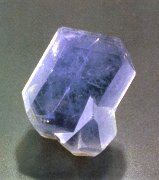 |
 |
 |
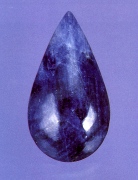 |
| 合成ソーダライト双晶 Synthetic Sodalite twin crystal 20.38ct 広州・中国地球化学研究所 Institute of Geochmistry of the Academia Sinica Guangzhou, China |
合成サファイアを思わせるほどの均一の 色合いの半透明なソーダライトのビーズ Synthetic sapphire-like semi-transparent sodalite beads 2.0 to 2.5mm diameter |
左のビーズの10倍の拡大写真 10x magnification |
ソーダライトのカボション (Sodalite cabochon) Potosi, Bolivia |
ソーダライトはラピスラズリの主要な成分ですが、単独のソーダライトは大量に採れることと、方解石などの不純物を含むこと、やや沈んだ色合い等からラピスラズリ程には珍重されません。
一般には床や壁など装飾用の建築材料として、或いはより均一な色合いの美しいものは手頃な値段のビーズやカボション、工芸品等に用いられます。
しかしながら写真のように、中にはまるで合成サファイアを偲ばせるほどの半透明の均一な色合いを示す魅力的なものもあります。
近年、冒頭の写真のルースのように近年アフガニスタンからはファセット・カットが可能な無色透明なソーダライト結晶が出現しました。
上の写真の透明なソーダライト結晶は1990年初頭に中国で試験的に合成されたものです。青い色は高エネルギー線の照射による発色です。
一般には不透明な団塊で産出するソーダライトに透明な結晶があり得ることを認識させられましたが、図らずも10年余りで実際に天然の無色透明な結晶がアフガニスタンで発見されたことになります。
* 冒頭の透明なルースは当初ソーダライトとして入手しましたが、長波紫外線で杏色の蛍光を発するためハックマナイトと判断しています。
Despite the major component of lapis-lazuli, Sodalite is not highly appreciated as lapis-lazuli, due to abundance, heavy inclusion of calcite and dark color, and is applied as ornamental material and for inexpensive accessories and carving.
However, as shown in the above photo, some sodalite is quite attractive for synthetic sapphire-like semi-transparency and even color. And as shown in the top photo, facettable tranparent sodalite crystals ( * it was labeled as sodalite, but was proved to be hackmanite because of apricot color phosphorescence under long wave U.V. radiation) are now being collected from Afghanistan, quite recently. Sodalite crystal was experimentally synthesized in early 1990's in China, which was subsequently irradiated to produce an attractive blue color.
ソーダライトの発色の仕組み (Cause of color in Sodalite)
ラピス・ラズリや藍方石の輝かしい青の発色は微量に含まれる硫黄イオンの電荷移動による発色です。
しかし類似の化学組成を持つソーダライトのやや沈んだ青の発色は全く異なる仕組みで起こります ;
ソーダライトでは結晶内のアルミニウム又はシリコンの格子の空隙内に入り込んだ酸素イオンによる光の吸収による発色と考えられています。
Bright blue color of Lapis-lazuli and Haüyne derives from charge transfer by S3-, while in sodalite, depite same family mineral as the formers, dark blue color is caused by different mechanism : interstitial oxygen ion O- near Al or Si.
| Top | Gemhall |